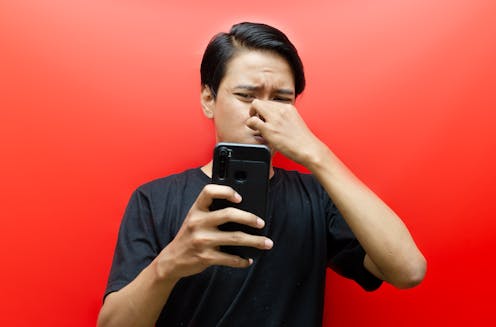Will your phone one day let you smell as well as see and hear what’s on the other end of a call?
Phones that transmit odors sound like science fiction, but researchers are working on making them real.


Curious Kids is a series for children of all ages. If you have a question you’d like an expert to answer, send it to curiouskidsus@theconversation.com.
Is it possible to make a phone through which we can smell, like we can hear and see? – Muneeba K, 10, Pakistan
Imagine this: You pick up your phone for a video call with a friend. Not only can you see their face and hear their voice, but you can also smell the cookies they just baked. It sounds like something out of a science fiction movie, but could it actually happen?
I’m a computer scientist who studies how machines sense the world.
What phones do now
When you listen to music or talk to someone on your phone, you can hear the sound through the built-in speakers. These speakers convert digital signals into physical vibrations using a tiny component called a diaphragm. Your ears sense those vibrations as sound waves.
Your phone also has a screen that displays images and videos. The screen uses tiny dots known as pixels that consist of three primary colors: red, green and blue. By mixing these colors in different ways, your phone can show you everything from beautiful beach scenes to cute puppies.
Smelling with phones
Now how about the sense of smell? Smells are created by tiny particles called molecules that float through the air and reach your nose. Your nose then sends signals to your brain, which identifies the smell.
So, could your phone send these smell molecules to you? Scientists are working on it. Think about how your phone screen works. It doesn’t have every color in the world stored inside it. Instead, it uses just three colors to create millions of different hues and shades.
Now imagine something similar for smells. Scientists are developing digital scent technology that uses a small number of different cartridges, each containing a specific scent. Just like how pixels mix three colors to create images, these scent cartridges could mix to create different smells.
Just like images on your phone are made of digital codes that represent combinations of pixels, smells produced by a future phone could be created using digital codes. Each smell could have a specific recipe made up of different amounts of the ingredients in the cartridges.
When you receive a digital scent code, your phone could mix tiny amounts of the different scents from the cartridges to create the desired smell. This mix would then be released through a small vent on the phone, allowing you to smell it. With just a few cartridges, your phone could potentially create a huge variety of smells, much like how red, green and blue pixels can create countless colors.
Researchers and companies are already working on digital odor makers like this.
The challenges to making smell phones
Creating a phone that can produce smells involves several challenges. One is designing a system that can produce thousands of different smells using only a few cartridges. Another is how to control how strong a scent should be and how long a phone should emit it. And phones will also need to sense odors near them and convert those to digital codes so your friends’ phones can send smells to you.
The cartridges should also be easy to refill, and the chemicals in them be safe to breathe. These hurdles make it a tricky but exciting area of research.
An odiferous future
Even though we’re not there yet, scientists and engineers are working hard to make smell phones a reality. Maybe one day you’ll be able to not only see and hear your friend’s birthday party over the phone, but also smell the candles they blew out!
Hello, curious kids! Do you have a question you’d like an expert to answer? Ask an adult to send your question to CuriousKidsUS@theconversation.com. Please tell us your name, age and the city where you live.
And since curiosity has no age limit – adults, let us know what you’re wondering, too. We won’t be able to answer every question, but we will do our best.
Jian Liu does not work for, consult, own shares in or receive funding from any company or organization that would benefit from this article, and has disclosed no relevant affiliations beyond their academic appointment.
Read These Next
Midlife weight gain can start long before menopause – but you can take steps early on to help your b
What you do in the years leading up to menopause can help counter the natural hormonal effects of aging,…
Deepfakes leveled up in 2025 – here’s what’s coming next
After a year of fast advances, deepfakes are entering a new era defined by real-time interaction with…
West Antarctica’s history of rapid melting foretells sudden shifts in continent’s ‘catastrophic’ geo
A picture of what West Antarctica looked like when its ice sheet melted in the past can offer insight…






